
Maybe I’m weird, but I read the manuals that come with most of the products I own. I don’t always read them before I start playing around with the product, but I almost always do sooner-or-later. Sometimes it’s a waste of time and I learn nothing new. Other times, I discover useful new features and capabilities that I might not have ever found otherwise.
I am especially diligent with the manuals for the automobiles I’ve owned over the years. Cars are complicated machines . . . and they’re among the most expensive products that most people own. When I get one, I want to know all of its ins-and-outs. I want to understand how its features work. And I can learn a lot of those things from the manual. Not everything, of course; most cars have ‘undocumented’ features and hacks that you can find in the service manual or enthusiast forums. Those are even more fun. But the regular owner’s manual can still provide a wealth of useful information.
Of course, in a modern car manual, there are a lot of disclaimers and legalese. It’s not uncommon to find a description of a feature, and then a warning instructing you to never-ever-ever use that feature unless you’ve signed a waiver, parked in a bubble-wrap sphere, and put on a helmet.
It wasn’t always that way. As I have mentioned before, I am the proud owner of a 1977 Jeep J-10 pickup (which is currently being restored). Its owner’s manual—which is actually an owner’s manual for the entire 1977 Jeep product line—does have some legalese warnings here-and-there, but overall it just tells you how the vehicles work and how you should take care of them. To a modern reader (like myself), it’s a bit disconcerting. But perhaps even more disconcerting are the features and oddities that are completely absent from modern cars . . . some of which deserved to land in the dustbin of automotive history, and others that ought to make a comeback.
Read on for some examples.
Actual, Non-Electronic Keys
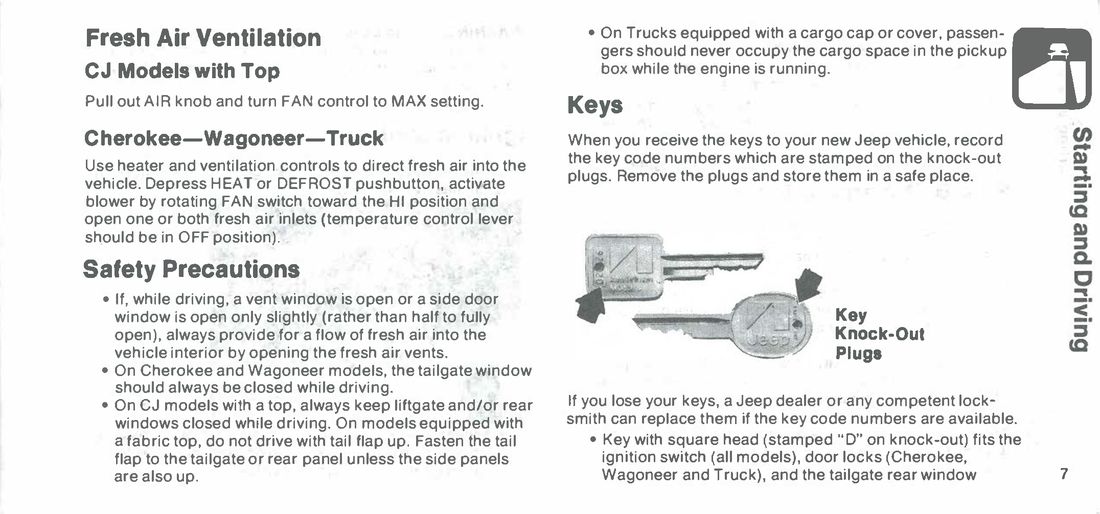
For many years, cars have had keys that include a radio device to prevent the car from starting unless the actual key is present. You can’t just make a copy at Home Depot . . . or jam a screwdriver into the column. It won’t work. Most also include a transmitter that can lock and unlock the car from some distance.
Many newer cars don’t even have keys in the traditional sense. The ‘key’ is just a radio transmitter that the car can detect. You keep it in your pocket. The car knows when to lock or unlock itself, and if you have the magic key in your pocket, you only need to push a ‘start’ button to start the car.
Because of all this high-falutin technology, replacing a lost or broken key can cost hundreds of dollars. Lame. But in 1977, a key was just a key. You had to put it in right-side-up because it wasn’t reversible, and, if you ever had to make a copy or get a replacement, it could be done by—as the manual clearly states—“any competent locksmith”.
Cold vs. Warm Starting

In modern cars that still have keys, you just put in the key in the ignition, turn it to the ‘start’ position, and the car starts. Many also have push-button start, where you just put in the key (or have it in your pocket) and push a button.
In 1977, things weren’t quite so simple. There was no fuel-injection and computer-control. Part of the process of starting the car was making sure that the engine was getting the fuel it needed . . . manually. If the engine was cold, you needed to floor the accelerator pedal and release it to set the automatic choke before turning the key to start. If the engine was warm, you needed to push the accelerator pedal “1/2 to 3/4 way down and hold” while you turned the key.
Three- and Four-Speed Transmissions

The few cars that are still available with a manual transmission pretty much all have five or more speeds. My 2004 Subaru Impreza WRX, for example, had a five-speed manual. Modern automatic transmissions typically have at least five speeds as well, and increasingly come with six or more. My 2008 Subaru Outback is somewhat unusual as a relatively modern car that has only a four-speed automatic.
In 1977, entry-level Jeeps came with a three-speed manual . . . something entirely unheard-of today. You could upgrade to a more advanced four-speed manual, or go really high-end with the three-speed automatic that my J-10 has. None of these options is available on any mainstream vehicle today.
Drum Brakes

Pretty much every modern car comes with disc brakes at every wheel . . . because disc brakes just work better than drums. In 1977, full-size Jeeps (like my J-10) came with disc brakes on the front wheels, which bear most of the braking forces, and less powerful drum brakes in the rear. Amazingly, Jeep CJ’s came with four drum brakes unless the buyer upgraded to front discs. Rear discs weren’t available on any model.
Because, you know, being able to stop your vehicle quickly isn’t that important.
As part of the restoration process on my J-10, we replaced the rear drum brakes with discs . . . so my truck will have disc brakes all-around, just like any modern car. Some things were better in the old days. Some things weren’t.
High-Beam Floor Switch
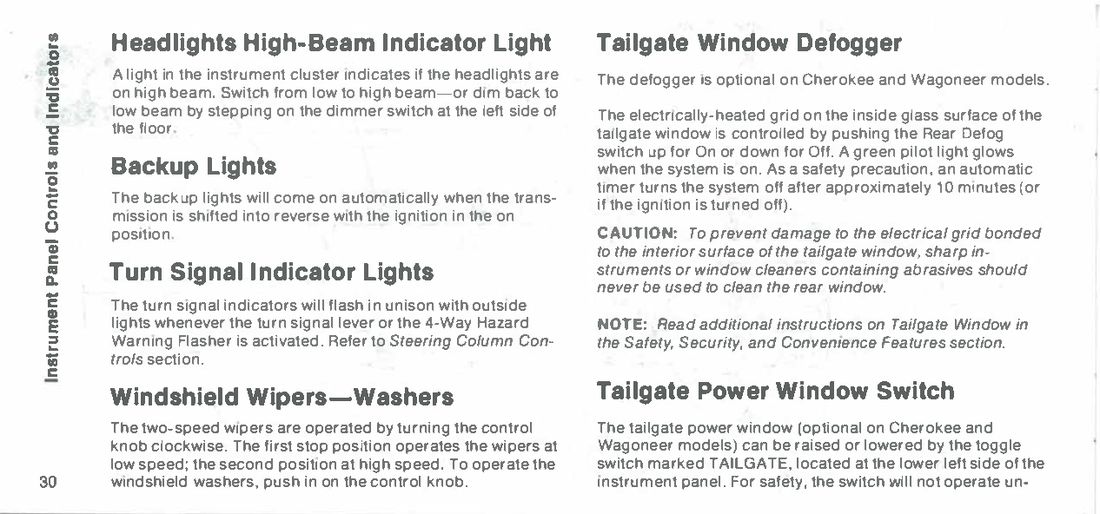
Every modern car (as far as I know) uses the turn-signal wand to toggle between the high- and low-beam headlights. The usual arrangement is that you pull the wand toward you while in the low-beam position to flash the high-beams, and push the wand away from you to fully engage the high-beams. You pull it back toward you to return to low-beams.
Some older cars did this in a different way. My family’s old Ford Aerostar, if I recall correctly, required you to pull the wand toward you to switch to high-beams, and then pull it toward you again to toggle back to low-beams.
In 1977, the high-beam control had not yet migrated to the turn signal wand. It was, instead, a floor switch that you operated with your left foot. Step on the switch to enable high-beams, and step on it again to return to low-beams. This is fine in my J-10 automatic, since drivers of automatics basically don’t use their left feet at all. It could be pretty annoying in a manual. If you ever had to toggle the switch while working the clutch, you were going to have problems.
Lighters and Ashtrays

The CDC estimates that, as of 2014, roughly seventeen percent of Americans are smokers. In 1977, smokers made up thirty-four percent of the population, and smoking was much more ‘socially acceptable’ than it is today.
Most modern cars don’t come with either a cigarette lighter or an ashtray unless you add a ‘smoker’s package’, and the ashtray you get is usually some little thing that slips into a cup holder. But in 1977, every Jeep came with a cigarette lighter and a built-in ashtray. For today’s smokers, this is a long-forgotten luxury.
Personally, although I don’t care about ashtrays, I do wish the lighter would make a comeback. You never know when you might need to light something on fire.
AM Push-Button Radio

No digital radio, no satellite radio, no Apple Carplay or Android Auto. Most 1977 Jeeps had an AM push-button radio as their standard ‘infotainment’ feature, although some—like the lowest trim of the J-10 pickup—came with no radio at all unless you added it as an option.
People who really wanted to splurge for the latest technology could upgrade to a similar radio that received both AM and FM!
Gear Shift and Hazard Switch on the Column

In today’s cars, the gear shift lever (if it even has one) is generally located in the center console between the driver’s and passenger’s seats . . . although some modern cars have switched to dials, buttons, and other space-saving alternatives. The hazard switch is typically a large, red button located somewhere near the middle of the center-stack of the dashboard; you push it to turn them on, and you push it again to turn them off.
Back in the dark ages, many vehicles had gear shift levers located on the steering column. In 1977, Jeep vehicles with a manual transmission had a floor-mounted shift lever, but those with an automatic—like mine—had it on the column. And hazard switches came in all shapes and sizes, but they were typically located somewhere on the steering column. In a 1977 Jeep, it was located on the right side of the column to the lower-left of the ignition switch.
Adjust-O-Tilt and Cruise Command

Today, most cars have tilt steering wheels and cruise control. But in 1977, Jeeps had Adjust-O-Tilt and optional Cruise Command!
This isn’t (quite) as silly as it sounds. Tilt steering wheels started to become common in the 1960s, and when American Motors Corporation (AMC) introduced their version on the Rambler, they called it the Adjust-O-Tilt. And in 1965, AMC introduced one of the first affordable cruise control systems, which they called Cruise Command. Since AMC was one of the early adopters of both technologies, they proudly created and used their own marketing names for them.
AMC purchased Jeep from Kaiser in 1970, and soon began incorporating their technologies into the Jeep product line. By 1977, every Jeep had a lot of AMC personality built-in . . . an AMC motor, of course, but also these old (but somehow endearing) marketing names for now-common features.
Also, note that the Adjust-O-Tilt “can be set in any of five positions even while driving.” This is true of any modern car, but the manual would never tell you so! The manual for my 2008 Subaru Outback has a big, obnoxious warning box that says, in part, “Do not adjust the steering tilt/telescopic position while driving. This may cause loss of vehicle control and result in personal injury.”
Manual Locks

Since the keys to a 1977 Jeep are actual keys, not radio transmitters, you have to unlock the doors by physically inserting the key into a key-hole and turning it . . . like some kind of barbarian.
From inside the vehicle, you operate the locks by physically raising or lowering a lock switch. This is basically the same as how modern car door locks can be operated from inside, except there is no switch to lock or unlock all of the doors simultaneously, so you must manually make sure the doors you want locked are locked, and the ones you want unlocked are unlocked.
That’s not too bad in my two-door J-10; it’s a bit more of a hassle in the four-door Cherokee and Wagoneer.
Lap Belts Only

In 1977, the full-size Jeeps like my J-10 had three-point seat belts (lap and shoulder) for both driver and passenger in the front, although if you had the bench seat, the middle passenger got only a lap belt. Rear passengers in the Cherokee and Wagoneer had only lap belts too.
I thought that three-point belts were standard across the board for driver and passenger by 1977, but apparently I was wrong . . . because Jeep CJ’s “are equipped with lap belts only for the front and rear seat occupants.” This probably makes sense, given that the CJ-5 and CJ-7 basically didn’t have sides or roofs. It’s still somewhat jarring to my modern sensibilities.
The Folding Windshield
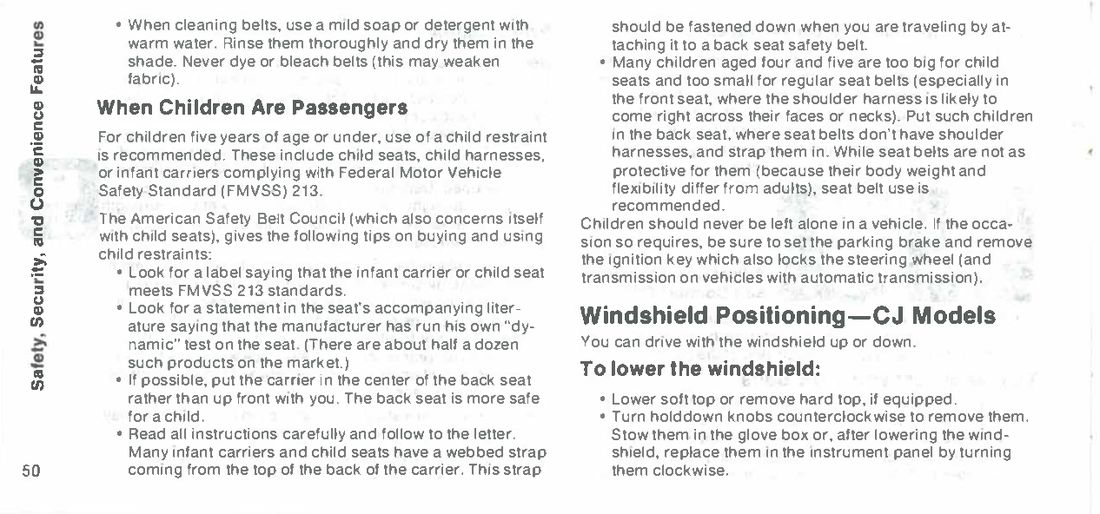
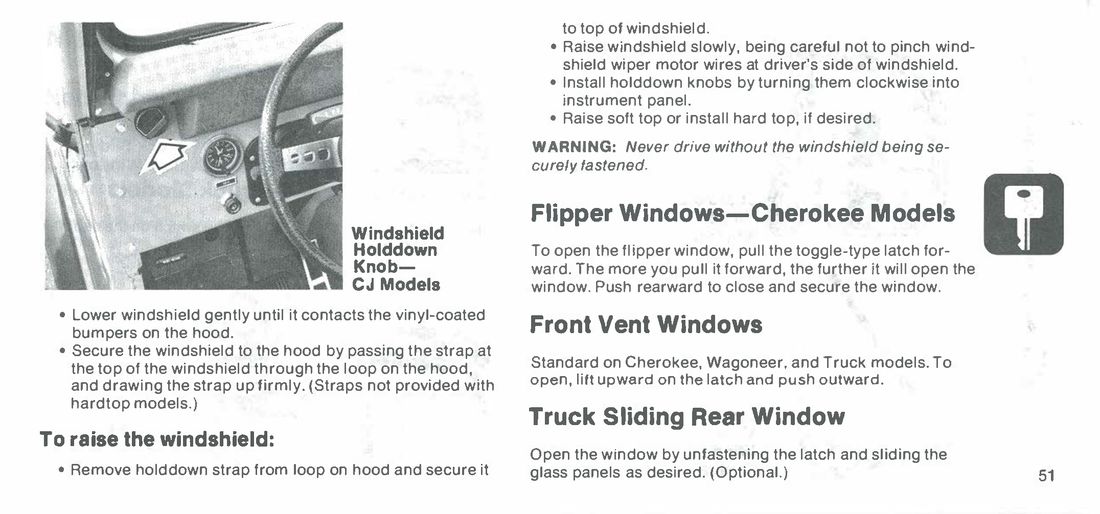 One of the few traditions that has continued from the original military Jeep all the way up to today’s Wrangler is the folding windshield . . . although the tradition is just barely hanging on today. I took a look in the manual for a 2016 Wrangler, and although it includes instructions for folding the windshield, it does everything it can to tell you not to.
One of the few traditions that has continued from the original military Jeep all the way up to today’s Wrangler is the folding windshield . . . although the tradition is just barely hanging on today. I took a look in the manual for a 2016 Wrangler, and although it includes instructions for folding the windshield, it does everything it can to tell you not to.
In the text introduction it says, “Do not drive your vehicle on-road with the windshield down and the side bars removed as you lose the protection these structural elements can provide. . . . Raise the windshield and reinstall the side bars as soon as the task that required their removal is completed and before you return to on-road driving.” There is, of course, a warning call-out that basically says the same thing again. And after all of that, there is a thirteen-step process to get the windshield folded down if you’re willing to take the risk.
Compare to the instructions for the 1977 CJ. The manual nonchalantly informs us that, “You can drive with the windshield up or down,” and then provides four steps to do so . . . basically, you turn a couple of knobs, lower the windshield, and tie it down. No bolts. No nonsense. The only warning we get is this: “Never drive without the windshield being securely fastened.”
Jeep Brand Mouth-to-Mouth


The 1977 Jeep manual includes first aid instructions, including instructions for providing artificial respiration (mount-to-mouth) . . . because, “The American Academy of Family Physicians suggests that every driver should be aware of a few first aid measures which might save the life of an auto accident victim.”
Well, okay.
I know that the first thing I do when I come upon an accident scene is consult my vehicle’s owner’s manual for guidance.
Hubris

Most of what’s on this page makes a lot of sense. It is in a section about how to operate a Jeep off-road safely. But I just couldn’t get over the sheer hubris buried in the ‘Across Slopes’ section: “A Jeep vehicle will seldom encounter a hill which it cannot negotiate directly.”
Of course, in 1977 that was true . . . but still, even if it was true today, that’s not the sort of thing that any modern car company would put in writing . . . because it invites customers to test it.
Leaded Fuel
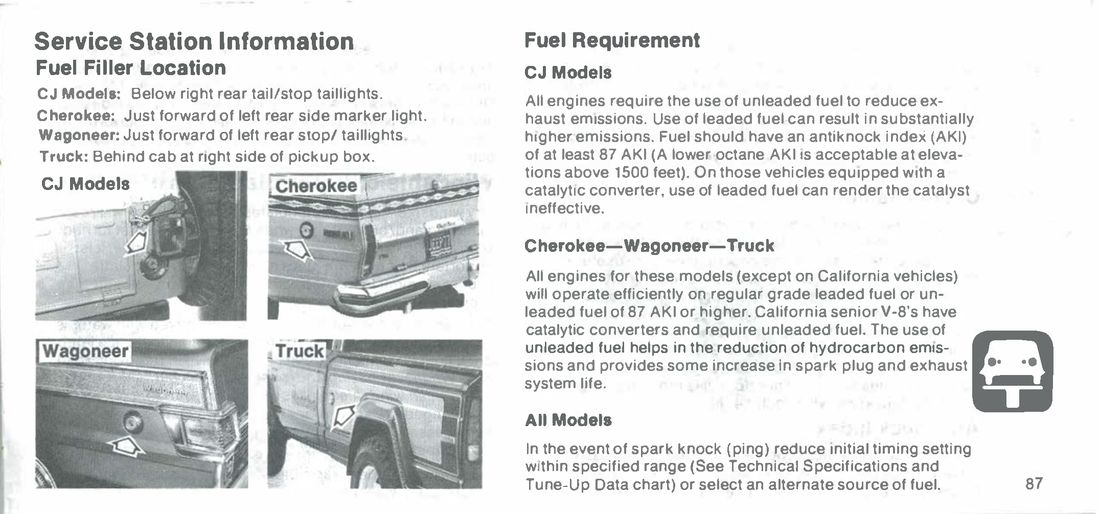
1977 was somewhere in the middle of the transition from leaded gasoline to safer (but more knock-prone) unleaded gas. All 1977 Jeeps were designed to work with regular unleaded fuel of at least 87 AKI, but the full-size Jeeps—Cherokee, Wagoneer, and trucks like my J-10—could still use regular grade leaded fuel too.
So if you have a few gallons of leaded fuel stashed somewhere, I can burn it for you.
Secret Special Lubricant
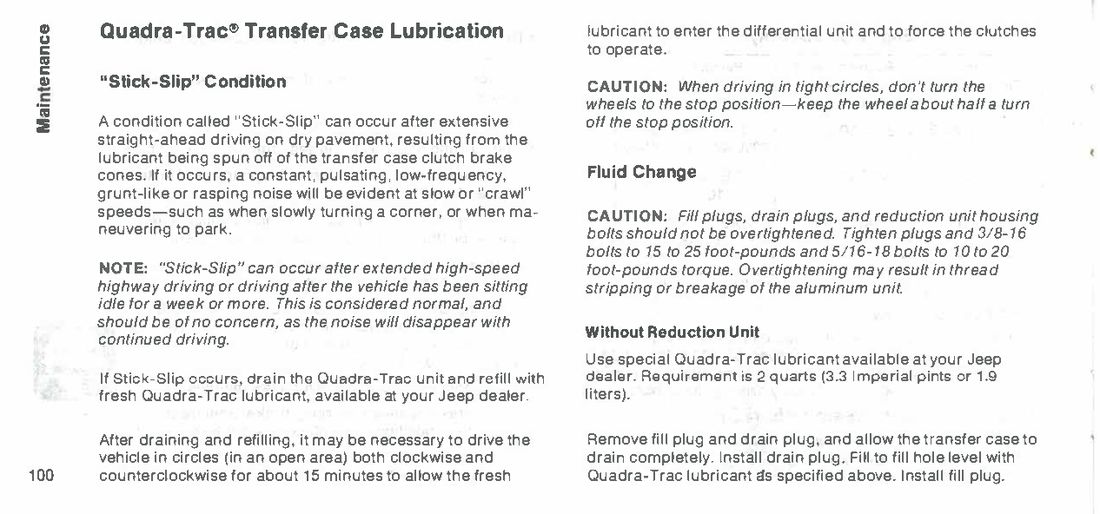
All 1977 Jeeps came with four-wheel-drive . . . as every Jeep always should. Do you hear me, Fiat Chrysler? A traditional part-time system came standard, where you drive it in rear-wheel-drive mode for normal day-to-day driving, but could shift into a four-wheel-drive mode (high or low range) when needed.
A full-time four-wheel-drive system called Quadra-Trac was an option on all 1977 Jeeps except the CJ-5. It is an automatic system similar to modern all-wheel-drive systems like those used by Subaru, where the system is always sending power to all of the wheels, and shifting it around as-needed when traction is lost. My J-10 has the Quadra-Trac system.
According to the manual, the lubricant for the Quadra-Trac transfer case (which is really a center differential) is a “special Quadra-Trac lubricant available at your Jeep dealer.” That could be a problem; I doubt that my local Fiat Chrysler dealerships are still selling top-secret AMC lubricants from the 1970s.
Luckily, there are enough fans of classic Jeeps out there that this won’t be an issue. An aftermarket supplier makes a compatible lubricant, and the folks on the Jeep forums have figured out that you can just mix your own by getting some 30w non-detergent motor oil and adding limited-slip differential additive.
And Finally . . .

